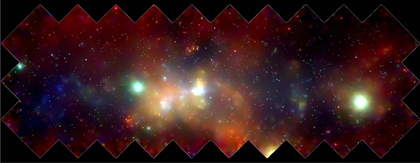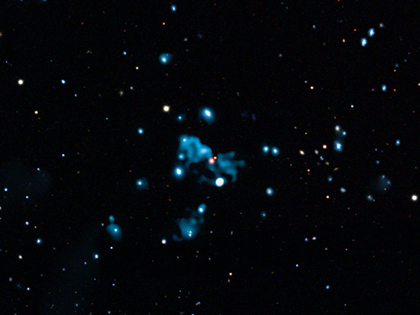Taking Our Galactic Self-portrait
One of Chandra's most iconic images is that of the center of our Galaxy. We should say, more accurately, that this image is just a small piece of Milky Way's center. This image - which stretches some 900 light years in one direction and 400 light years in the other - is actually a montage of 30 separate Chandra images that have been stitched together to create this stunning X-ray tableau. Even with all of that data, this image still only represents a small fraction of the plane of the Milky Way, which stretches some 100,000 light years across (again, compared to just 900 light years in our image.) But even in that relatively small space, we see how amazing our Galaxy is. There's a supermassive black hole and hundreds of other objects, including neutron stars, smaller black holes, stars and more.
But when do we get a full picture of the Milky Way? The answer is we don't. Since our Solar System is embedded within our Galaxy, we never get a real astronomical image of what it looks from the outside as produced by a telescope. (What we see when we are "looking" at a complete picture of the Milky Way is an artist's representation - or another spiral galaxy that is standing in as its stunt double.)
Ghost Remains After Black Hole Eruption
This is a composite image showing a small region of the Chandra Deep Field North. Shown in blue is a deep image from the Chandra X-ray Observatory and in red is an image from the Multi-Element Radio Linked Interferometer Network (MERLIN) an array of radio telescopes based in Great Britain. An optical image from the Sloan Digital Sky Survey (SDSS) is shown in white, yellow and orange.
A GPS System for Cosmic Images
Imagine getting a picture of some random patch of the Earth. This picture has some features on it - maybe a mountain or a river or even a city - but from the altitude it was taken, you can't be exactly sure what's what. And then imagine if someone asked you to place it exactly where it should lie on the Earth. Really hard, right?

It's New Hampshire - USA
Well, of course, it gets a lot easier if someone were to give you the exact longitude and latitude. While this seems like an obvious thing to do, it's not so simple for astronomical images. When astronomers create their images for scientific purposes, these images retain certain coordinate information - like longitude and latitude - but for space. Unfortunately, when these images get processed further to make them attractive for the public, this information gets stripped out. In other words, we're back to having no clue where this image matches up with anything else.
Carnival of Space
Many of this week's blogs focused on that little-known telescope that's being invaded by a spaceship. In case you missed it, the telescope is called "Hubble" and the spaceship is our Space Shuttle Atlantis. Naturally, the astro-blogosphere took notice. In his "Dynamic of Cats" blog, Steinn Sigurdsson talks about the last pretty picture to come out of that workhorse instrument with the stubborn screw -- Wide Field/Planetary Camera 2.

The Bigger Picture
Take a look at "The Bigger Picture," a blog produced by the Smithsonian Photography Initiative (SPI). It aims to present an inside look at the Smithsonian's photography collections and invites audiences to engage in an online discussion about photography's powerful impact on our world. We contributed a post on "Seeing the Invisible (part I)" that you might enjoy: http://blog.photography.si.edu/2009/05/11/seeing-the-invisible/
-Kim Arcand, CXC
An Intriguing Glowing Galaxy
Activity from a supermassive black hole is responsible for the intriguing appearance of this galaxy, 3C305, located about 600 million light years away from Earth. The structures in red and light blue are X-ray and optical images from the Chandra X-ray Observatory and Hubble Space Telescope respectively. The optical data is from oxygen emission only, and therefore the full extent of the galaxy is not seen. Radio data are shown in darker blue and are from the National Science Foundation's Very Large Array in New Mexico, as well as the Multi-Element Radio-Linked Interferometer Network in the United Kingdom.
Chandra's One-time Shuttle Trip
This week, the Space Shuttle Atlantis will return to the Hubble Space Telescope for a fifth and final time. The mission will bring the telescope new instruments, batteries, and gyroscopes that will extend its lifetime for hopefully several years or more.
This year marks the 10th anniversary that the Shuttle launched and deployed Chandra . There haven't been any visits since and none will ever take place. That's because Chandra was designed to be different than Hubble -- in more ways than just the type of radiation it detects.

Resolving a Galactic Mystery
An extremely deep Chandra X-ray Observatory image of a region near the center of our Galaxy has resolved a long-standing mystery about an X-ray glow along the plane of the Galaxy. The glow in the region covered by the Chandra image was discovered to be caused by hundreds of point-like X- ray sources, implying that the glow along the plane of the Galaxy is due to millions of such sources.
Meet an Astronomer: Eli Bressert
In this latest installment of our series, we sit down with Eli Bressert. Eli is responsible for making the Chandra images for the public that appear in press releases, on the website, in posters, etc. While we won't get into the technical details of how that gets done in this video blog, we did want to point out that this an important -- if lesser known -- job in the world of space science.
"Hand"ling Information in Today's World
We've been publicizing and distributing Chandra results for nearly ten years now. One interesting trend we've watched over this time is how much things have changed in how people get their information. Back in the day, we would write a press release - sometimes even printing on paper! – and this would go to science reporters, who, in turn, would write articles for their newspapers, radio programs, or TV reports. The public would generally learn about our results by seeing them through these outlets.



